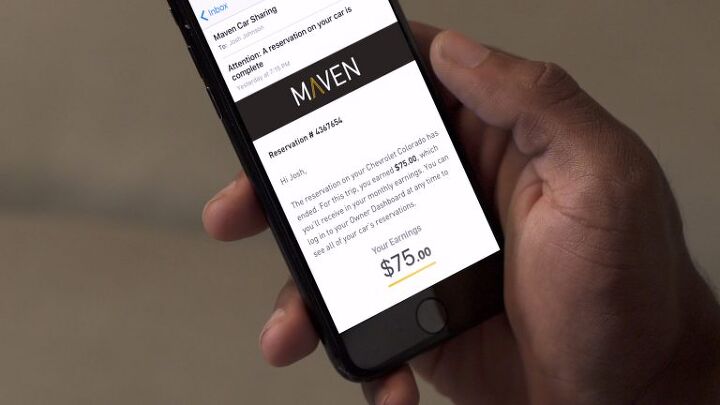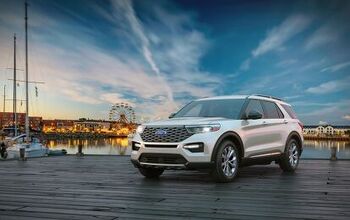An Experiment in Error? Maven Bites the Dust, GM Lauds 'Insights' Gained

The great General Motors ride-sharing experiment is over. At least for now. Maven, which hit parking lots in 2016 and eventually expanded into the nation’s driveways, was GM’s attempt to put its vehicles to work, rather than sell them to retail or fleet customers like some kind of dinosaur.
For a fee, users could access the GM-owned fleet of Maven products to perform random driving tasks. Short trips, mainly, in the absence of an Uber or Lyft ride or participation in a more formal car-sharing agreement. Tap that app, find the car, unlock it, and drive off. Abandon somewhere after you’re done.
Well, that’s what GM just did with Maven.
As reported by The Verge, the company sent out notices to users on Tuesday notifying them of the “immediate” suspension of the Maven experiment.
“After critically looking at our business, the industry, and what’s going on with COVID-19, we have made the tough but necessary decision to wind down our business,” the automaker wrote to its customers.
Maven services went offline in March due to the coronavirus pandemic, but today’s message confirms a permanent cancellation. GM’s efforts to insert Maven services into various American and Canadian cities came as the automaker explored new revenue streams in the dawning (and dazzlingly promising) Age of Mobility. Thing is, the windfalls promised by such business models have, for the most part, failed to materialize. Maven was not a money maker.
Despite the service’s expansion into other pilot projects, last year brought suggestions of trouble ahead.
In January 2019, Jill Steyn, who oversaw the launch and guided Maven through its first two-plus years, abruptly left the company. Before Steyn’s departure, the service had branched out with Maven Gig, a rental service providing vehicles to rideshare and delivery drivers. In 2018 came peer-to-peer carsharing, allowing owners of newer GM vehicles to earn money by renting out their rides to Maven customers. That service ultimately expanded to 10 cities.
Shortly before her departure, Steyn spoke of adding non-GM vehicles to the service.
Taking over from Steyn in February 2019 was Sigal Cordeiro, a 19-year GM veteran who formerly served as executive director of global product marketing for the automaker’s overseas GEM vehicle platform. Nothing new emerged from Maven after that point.
Partway through last year, Maven announced it was pulling its services from several large U.S. cities, among them New York City, Chicago, and Boston, signalling that the experiment may have gone as far as it could. The pandemic seems to have been the final straw.
In a statement published by The Verge, Pamela Fletcher, GM’s vice president of global innovation, said, “We’ve gained extremely valuable insights from operating our own car-sharing business.”
“Our learnings and developments from Maven will go on to benefit and accelerate the growth of other areas of GM business.”
General Motors would now like to have a word with you about the zero-percent/84-month financing available to eligible buyers.
[Image: General Motors]

More by Steph Willems
Latest Car Reviews
Read moreLatest Product Reviews
Read moreRecent Comments
- Haze3 EV median weight is in the range of 4500-5500lbs, similar to the low end of full size pickup trucks and SUV's or typical mid-size PU's and SUV's. Obviously, EV Hummers and PU's are heavier but, on average, EV=PU or mid/full SUV is about right. EV's currently account for ~1% of the cars on the road. PU's account for 17% and SUV's count for over 40%. If we take out light SUV's, then call it 30% SUV or so. So, large-ish PU's and SUV's, together, account for ~50% of the US fleet vs 1% for EV's. As such, the fleet is ALREADY heavy. The problem is that EV's will be making the currently lighter 50% heavier, not that PU/SUV haven't already done most of the damage on avg mass.Sure, the issue is real but EV responsibility is not. If you want to get after heavies, that means getting after PU/SUV's (the current problem by 40-50x) first and foremost.
- Redapple2 Telluride over Acadian (sic-tip cap-canada). 1 better car. 2 60 % us/can content vs 39 THIRTY NINE for an "American" car. 3 no UAW labor. Smart people drive Tellurides. Not so smart for the GMC. Dont support the Evil GM Vampire.!
- Theflyersfan My dad had a 1998 C280 that was rock solid reliable until around 80,000 miles and then it wasn't. Corey might develop a slight right eyelid twitch right about now, but it started with a sunroof that leaked. And the water likely damaged some electric components because soon after the leaks developed, the sunroof stopped working. And then the electrical gremlins took hold. Displays that flickered at times, lights that sometimes decided illumination was for wimps so stayed home, and then the single wiper issue. That thing decided to eat motors. He loved that car but knew when to fold the hand. So he bought a lightly used, off lease E-class. Had that for less than two years before he was ready to leave it in South Philly, keys in the ignition, doors unlocked, and a "Take it please" sign on the windshield. He won't touch another Benz now.
- Detlump A lot of people buy SUVs because they're easier to get in and out of. After decades of longer, lower, wider it was refreshing to have easier ingress/egress offered by an SUV.Ironically, the ease of getting in and out of my Highlander is very similar to my 56 Cadillac.
- Redapple2 LP Michigan. Long straights. A long sweeper. 2 chicanes. 4 hard turns. Lenghts of each element are different but similar to LeMans.


































Comments
Join the conversation
Wow this place is full of some super unintelligent douchebags. It's like clique central for rtards and morons. Great job TTAC, you've done a great job killing this site!
I've been kinda considering a used Chevy Bolt EV. Recently, a metric buttload of them appeared all at once on the market in California -- only a year or two old and at bargain prices. But on closer inspection, they all had 100,000 miles and scratched-up rear door panels. Now it makes sense. My guess is, those are the Maven Gig cars. Maven Gig, GM's lease-by-the-day program, was very popular with rideshare drivers -- every Chevy Bolt EV they had in greater L.A. was reserved again the moment it reappeared on the map. Incidentally, they all seemed to have wound up at the faux-upscale lots that pepper California's Inland Empire. These lots peddle late-model cars at utterly irresistible prices. The catch is a) an accident history, disclosed or not, b) very high miles for the year, c) an undisclosed $3000 dealer fee that they try to hide in the paperwork, or d) all of the above. Word to the wise: avoid any place with Warehouse, Wholesale, or Direct in the name...it's a scam.